
A panoramic image showing the positive impact around the greens as festival goers leave, taken by Kylie Barton
This year's Glastonbury may have been the muddiest on record according to founder Michael Eavis, but it was also one of the greenest!
Last year Glastonbury Festival piloted a project conceived by Steve Pagett, long standing Green Futures crew member, with the help of Fiona Brookes and the Young Greens. This year the project expanded to be four times bigger. The aim of the project is to encourage campers to 'love the farm, leave no trace' - a long standing mantra of the festival. The pilot in 2015 was proved, with campsite surveys run by university students who returned in 2016 too, as well as visual auditing of the site showing significant green spaces free from litter surrounding the villages' location.

An aerial shot of two of the 6 village greens last year. Image sourced from Kylie Barton at Salt.
Glastonbury spends around £800,000 on the clear up every year after festival goers retreat. This is money which could go to many of the partner charities or to reduce the cost of the ticket. The ethos of the project is not to preach, but to nudge, and connect the dots for people between their actions and the impact on the farm and the festival.
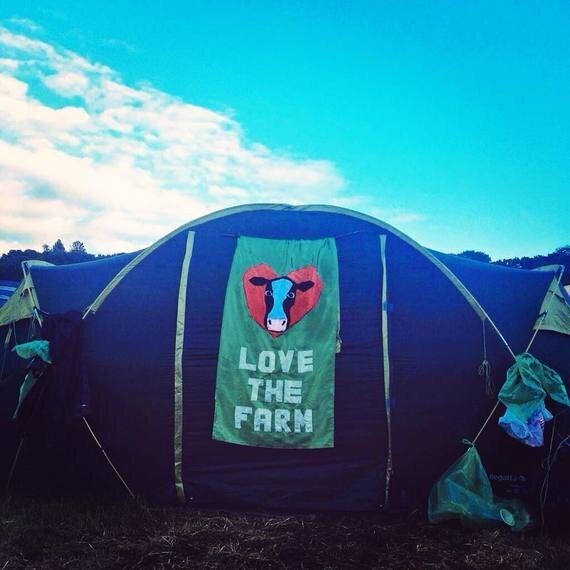
Love the farm, one of the banners created by Hannah Taylor for the project, taken by Kylie Barton
So what exactly happened last year?
To take on this huge task last year a group of volunteers set up camp on the most infamous plot - Pennards Hill and created village greens in the form of willow circles and hand built benches; a protected green space in a field of approx. 40,000 festival goers.
Initiatives that worked well last year included making ashtrays out of beer cans, making recycling easier through greater access to bin bags and creating centralised points within the camping fields, helping campers pack up their stuff, and generally chatting about why this is all so important. Another surprise success was the pathways to water points, loos, and the main track.
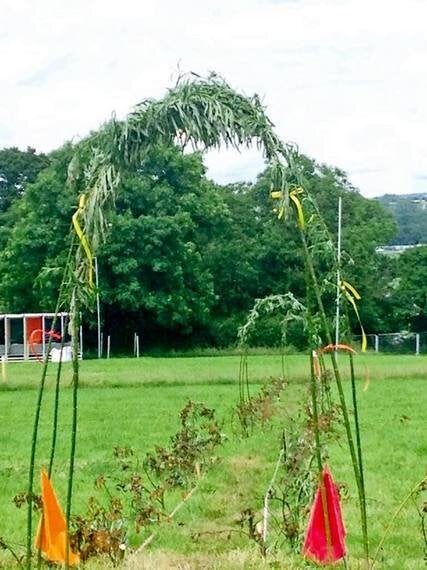
A freshly laid path awaiting the public's arrival, taken by Kylie Barton
Project lead Fiona Brookes said:
"Last year went better than we ever could imagine. There was an expectation that festival goers would be resistant to being encouraged to camp sustainably, but the positive response and engagement to a community led approach was staggering. It proved that given the right environment and tools at their disposal people will chose to be sustainable as the benefits are obvious. Sustainable living isn't about harsher conditions or living with less, it's about improving quality of life for all not just a few."
On the back of last year's success Village Greens Communities were asked to return with last year's project manager Fiona Brookes coordinating alongside Mr Pagett with a wider pool of volunteers.
What was new this year?
This year Glastonbury requested that the project be rolled out across more campsites due to the achievements of last year's pilot. Village Greens Communities enjoyed increased support for 2016 in the form of informed and keen campsite stewards, and over 200 'Worthy Warriors' who were members of the public who signed up to the initiative beforehand to camp in a Village Green and spread the message. These warriors also got handed medals from the stewards for their hard work, and the feedback from their experience of interacting with festival goers was overwhelmingly positive.
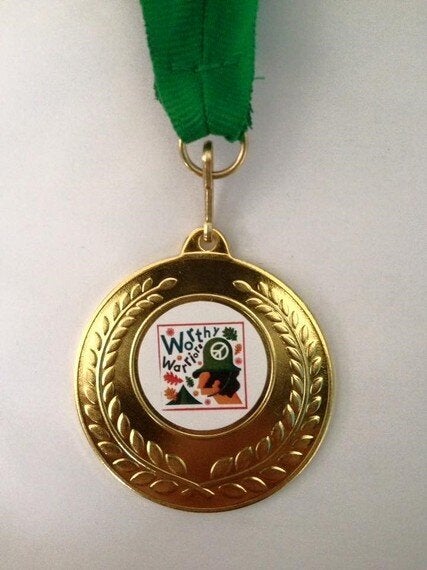
The medal that was handed to Worthy Warriors for their excellent work. Image from Tunk Tunk.
This year around 40 volunteers (around half of whom took part last year) took on 6 campsites, creating a total of 24 greens for the public to enjoy. The expansion wasn't without it's challenges to overcome, but was an overwhelming and heart-warming success which the teams look forward to building upon next time around. One festival goer commented:
"It is so nice to see this happening, its bringing it back to what Glastonbury used to be like - the sense of community, shared responsibility and connecting with the natural world around us. The greens were a great place to relax, chat, find out information, and to see an area so clean in the middle of a festival was refreshing - and infectious! It definitely had an effect on the state the public left their plot in in the immediate areas where I was, and probably further afield too as so many people used the pathways that almost everyone knew about it!"
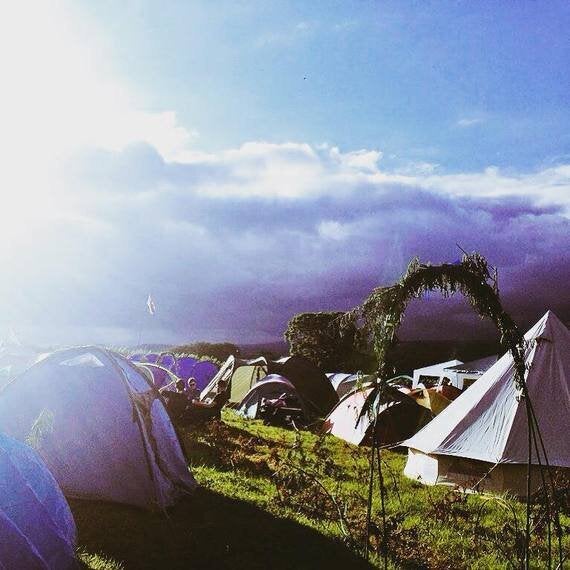
View from a village green through the willow arch down the pathway, taken by Kylie Barton
In addition to the tactics which proved popular last year, this year there was an increased focus on building positive relationships with the stewards who have worked the festival for many years. Village Green teams had tea and cake with stewards, and kept the dialogue moving throughout the festival to tackle any arising issues. The rapport with the security was also key, with teams gaining information on any issues within their campsite in real time, and security staff passing through to check in on the greens. The response was overpoweringly positive yet again and people reacted well to the overarching permaculture values of earth care, people care, and fair share.
As well as how the project interacted with the rest of the festival infrastructure, the developed relationships within the Village Green teams was also significant to this year's accomplishment. Communal meals with the whole group really built up team moral ready for the public's arrival, and teams made more of an effort to visit and support one another once the festival was underway which strengthened the whole project immeasurably.
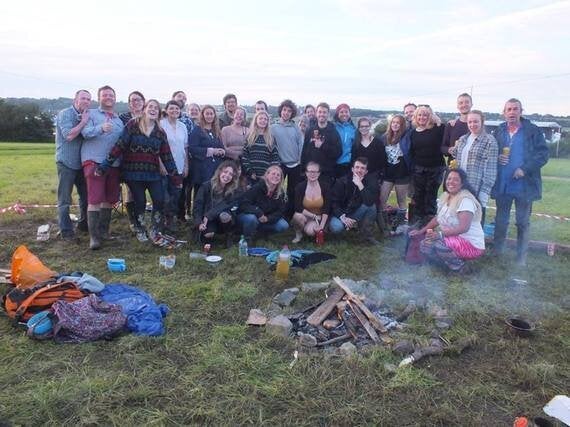
The team at a communal meal before the public arrived, taken by Cathy Baldwin team member
Glasto Transformed
With the Village Green Communities, Worthy Warriors, the steel cups, and more visible teams of litter pickers out and around the site throughout, it is clear Glastonbury is being transformed into a greener festival year on year thanks to the hard work of all those involved, not least the sustainability manager Lucy Smith who strategizes on such projects.
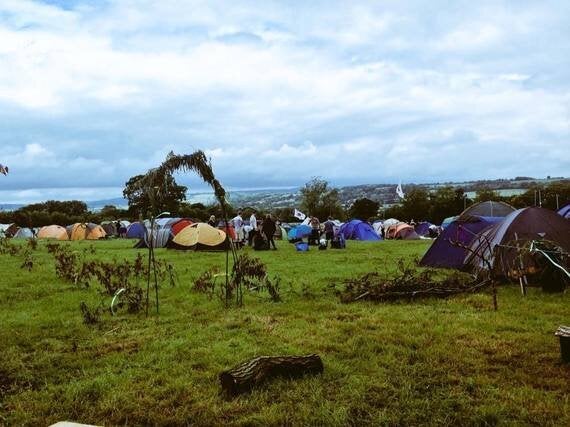
The public starting to arrive, taken by Kylie Barton
This kind of bottom-up social change is what is truly needed to challenge the waste culture festivals have been burdened with. Change must come from within - and the gentle nudge of some well-informed public campers is helping do just that.
View the 20th image down on this article to see the effects of one of the green's this year.